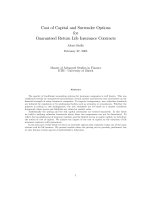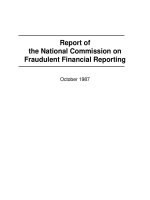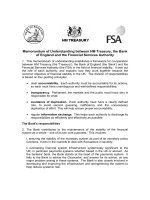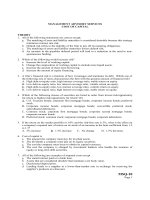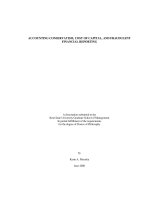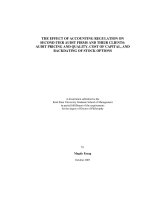Accounting conservatism, cost of capital, and fraudulent financial reporting
Bạn đang xem bản rút gọn của tài liệu. Xem và tải ngay bản đầy đủ của tài liệu tại đây (1.38 MB, 287 trang )
ACCOUNTING CONSERVATISM, COST OF CAPITAL, AND FRAUDULENT
FINANCIAL REPORTING
A dissertation submitted to the
Kent State University Graduate School of Management
In partial fulfillment of the requirements
for the degree of Doctor of Philosophy
by
Karin A. Petruska
June 2008
3316841
3316841
2008
ii
Dissertation written by
Karin A. Petruska
B.S.B.A., Youngstown State University, 1989
M.B.A., Youngstown State University, 1993
Ph.D., Kent State University, 2008
Approved by
_____________________________ Chair, Doctoral Dissertation Committee
Dr. Pervaiz Alam
_____________________________ Members, Doctoral Dissertation Committee
Dr. Kevin Dow
_____________________________
Dr. Wei Li
_____________________________
Dr. David Booth
Accepted by
_____________________________ Interim Doctoral Director, Graduate School of
Dr. Michael Hu Management
_____________________________ Dean, Graduate School of Management
Dr. Frederick Schroath
iii
ACKNOWLEDGEMENT
I would like to thank above all else, God, for blessing me and truly giving me the faith,
courage, inspiration, and steadfastness to continue on this journey in my life. He has always been
there whenever I needed him the most.
I would like to thank my dissertation chair, Dr. Pervaiz Alam, who has continuously
provided me with meaningful advice during many hours of discussion. I feel very fortunate to
have been able to work with Dr. Alam over the years. He has mentored me throughout my entire
Ph.D. program and has shared his experiences, wisdom, and knowledge as a researcher, for which
I am very grateful. He has shaped my doctoral experience and provided me with the necessary
skills to be successful in my academic career. Without his unwavering help and guidance, this
journey would not have been possible. I would also like to thank the other members of my
dissertation committee, Dr. Kevin Dow, Dr. Wei Li, and Dr. David Booth for their guidance,
support, advice, and helpful comments. My appreciation is also extended to Dr. Michael Hu and
Dr. John Thornton for their gracious efforts in presiding at my dissertation defense.
I would like to thank my parents, Robert and Ethel, who have always encouraged me and
have taught me to dream big, to never give up on those dreams, and to believe in what you do.
They have always kept my spirits soaring and showed me the importance of remaining positive
and providing help to those who need it. I dedicate this dissertation to them for providing love,
understanding, and encouragement during the pursuit of this degree. To my sisters, Melissa and
Heidi, I thank them for their caring, concern, and understanding.
While there are many other people who have contributed to my success in completing
this final degree, I am thankful to Jan Winchell for her computational assistance and to my fellow
Ph.D. students who have always made the days seem brighter and have always made me smile.
iv
TABLE OF CONTENTS
Page
CHAPTER 1 INTRODUCTION
1.1 Background and Purpose……………………………………………………… 1
1.2 Litigation Risk………………………………………………………………………. 5
1.3 Regulation and Standard Setting……………………………………………………. 7
1.3.1 The Private Securities Litigation Reform Act (PSLRA) of 1995………………… 8
1.3.2 The Sarbanes-Oxley Act (SOX) of 2002…………………………………………… 9
1.3.3 Standard Setting…………………………………………………………………… 11
1.4 Cost of Capital………………………………………………………………………. 13
1.5 Purpose……………………………………………………………………………… 14
1.6 Motivation for Study………………………………………………………………… 16
1.7 Research Contribution……………………………………………………………… 19
1.8 Research Expectations and Methodology……………………………………………. 21
1.9 Sample Selection…………………………………………………………………… 24
1.10 Organization of the Study……………………………………………………………. 26
CHAPTER 2 LITERATURE REVIEW
2.1 Background and Purpose…………………………………………………………… 27
2.2 Definition and Relevance of Earnings Quality………………………………………. 27
2.3 Definitions of Accounting Conservatism……………………………………………. 29
2.4 Research Studies on Accounting Conservatism…………………………………… 31
2.4.1 Circularity Issue Relating to Accounting Conservatism…………………………… 38
2.5 Determinants of Fraud……………………………………………………………… 38
2.6 Limitations of Prior Research Methods……………………………………………… 41
2.6.1 Accruals……………………………………………………………………………… 41
2.6.2 Frequency Distributions……………………………………………………………… 42
2.7 Extensions of the Basu (1997) Model and Alternate Measures……………… ……. 42
2.7.1 Real Activities Manipulations……….……………………………………………… 44
2.8 Cost of Equity Capital………………….…………………………………………… 45
CHAPTER 3 HYPOTHESES AND RESEARCH DESIGN
3.1 Hypotheses Development……………………………………………………………. 48
3.2 Methodology…………………………………………………………………………. 58
3.2.1 Univariate Descriptive Statistics…………………………………………………… 58
3.2.2 Measures of Conservatism…………………………………………………………… 59
v
TABLE OF CONTENTS (continued)
3.2.2.1 The Basu (1997) Model……………………………………………………………… 59
3.2.2.2 Earnings Persistence………………………………………………………………… 62
3.2.2.3 Conservatism and the Sarbanes-Oxley (SOX)Period…………………………………. 63
3.2.3 Alternate Accounting Conservatism Measures………………………………………. 64
3.2.3.1 Accruals Adjusted for Asymmetrical Timeliness……………………………………. 64
3.2.3.2 Q-Score……………………………………………………………………………… 67
3.2.3.3 Earnings Variability and Earnings Smoothness……………………….……………… 68
3.2.3.4 Nonoperating Accruals…………………… ……………………………………… 69
3.2.3.5 Skewness of Earnings……….…… ………………………………………………… 70
3.2.4 Cross-Sectional Variation of Accounting Conservatism…………………………… 70
3.2.5 Measures of Standard Setting………………………………………………………… 72
3.2.6 Measures of Cost of Equity Capital………………………………………………… 74
3.2.7 Cross-Sectional Variation of Cost of Equity Capital Estimates……………………… 77
3.3 Sample Selection and Data Sources………………………………………………… 79
CHAPTER 4 EMPIRICAL RESULTS
4.1 Introduction………………………………………………………………………… 82
4.2 Sample Identification………………………………………………………………… 83
4.3 The Matched Control Sample……………………………………………………… 84
4.3.1 Sample Selection and Distributions……….………… …………………………… 85
4.4 Econometric Issues…… …………………………………………………………… 90
4.5 The Basu (1997) Model of Aggregate Asymmetric Timeliness……………………… 94
4.5.1 The Basu (1997) Model of Aggregate Asymmetric Timeliness of Earnings in the
Year of the Fraud Manipulation ……………………………………………………… 94
4.5.2 The Basu (1997) Model of Aggregate Asymmetric Timeliness of Earnings
Surrounding the Year of Fraud Manipulation………… ………………………… …. 98
4.5.3 Pooled, Cross-Sectional, Time Series Basu (1997) Regression Model………… 101
4.5.4 Asymmetric Timeliness of Operating Accruals, Cash Flows and Earnings……… … 104
4.5.5 Pooled, Cross-Sectional, Time Series Persistent Versus Transitory Earnings… 107
4.6 Sensitivity Tests………………………………………………………………………. 109
4.6.1 Asymmetric Timeliness of Earnings Using Fraud as a Dummy Variable Indicator…. 109
4.6.2 Fama-Macbeth (1973) Statistics.…………………………… ………………………. 110
4.6.3 The Basu (1997) Model of Aggregate Asymmetric Timeliness of Earnings after
Extraordinary Items and Discontinued Operations…………………………………… 111
4.6.4 Market-Adjusted Returns………………………………………………………… 112
4.6.5 Alternate Matching of Nonfraud Firms………………………………………………. 113
4.6.6 Controlling for Large Corporate Scandals……………………………………………. 113
4.7 Asymmetric Timeliness and the Sarbanes-Oxley Act (SOX) of 2002……… ……… 114
vi
TABLE OF CONTENTS (continued)
4.7.1 Asymmetric Timeliness of Earnings and the SOX Act of 2002 Partitioned by
Alleged Fraud and Nonfraud Firms……………………… ………………………… 114
4.7.2 Sensitivity Test of Asymmetric Timeliness of Earnings and the Sarbanes-Oxley
Act (SOX) of 2002 for All Firms…………………………………………………… 115
4.7.3 Alternate Sarbanes-Oxley (SOX) Timing Date………………………………………. 117
4.8 Asymmetric Timeliness for Firms Reporting Goodwill Impairment……………… 117
4.8.1 Asymmetric Timeliness of Earnings for Firms Reporting Goodwill Impairment……. 118
4.8.2 Sensitivity Test of Asymmetric Timeliness of Earnings for All Firms Reporting
Goodwill Impairment…………………………………………………… 119
4.9 Firm-Specific Measures of Accounting Conservatism……………………………… 120
4.9.1 Introduction…………………………………………………………………………… 121
4.9.2 Descriptive Statistics and Correlation Coefficients………………………………… 122
4.9.3 Control Variables…………………………………………………………………… 123
4.9.4 Financial Statement Measures of Variables Representing Accounting Conservatism 125
4.9.5 Sensitivity Tests for Financial Statement Variable Measures of Accounting
Conservatism Relating to the Market-to-Book Ratio…………………………………. 128
4.9.6 Sensitivity Tests for Other Additional Financial Statement Variable Measures of
Accounting Conservatism…………………………………………………………… 130
4.10 Accruals-Based Measures of Variables Representing Accounting Conservatism……. 131
4.10.1 Income-Decreasing Discretionary Accruals Models…………………………………. 132
4.10.2 Sensitivity Tests for Firm-Specific Accrual Measures of Accounting Conservatism 135
4.11 Firm-Specific Measure of Accounting Conservatism and the Post-SOX Period…… 138
4.11.1 Financial Statement Measures of Variables Representing Accounting Conservatism
and the Post-SOX Period…………………………………………………………… 138
4.11.2 Accruals-Based Measures of Variables Representing Accounting Conservatism and
the Post-SOX Period……………………… ………………………………………… 139
4.12 Summary……………………………………………………………………… ……. 141
4.13 Cost of Equity, Conservatism, and Fraudulent Financial Reporting………………… 142
4.13.1 Introduction………………………………………………………………………… 142
4.13.2 Empirical Results……………………………………………………………………. 144
4.13.3 Cost of Equity and Financial Statement Measures of Accounting Conservatism…… 145
4.13.4 Cost of Equity and Financial Statement Measures of Accounting Conservatism
Surrounding the SOX Act…………………………………………………………… 149
4.13.5 Sensitivity Test for Multiple Disclosure…………………………………………… 150
4.14 Additional Insights into Accounting Conservatism by Alleged Fraud Firms……… 151
4.14.1 Agency Theory and Earnings Management…………………………………………. 152
4.14.2 Earnings Management and Disclosure………………………………………………. 153
4.14.3 Accounting Conservatism and Information Asymmetry…………………………… 153
4.14.4 Theoretical Models of Accounting Conservatism……………………………………. 155
4.14.5 Accounting Conservatism and Alleged Fraud Firms……………………………… 158
4.14.6 Conservatism and Earnings Management……………………………………………. 159
4.14.7 Additional Sensitivity Tests………………………………………………………… 160
vii
TABLE OF CONTENTS (continued)
4.14.8 Alternate Specification of Litigation Risk…………………………………………… 162
4.15 Industry Effects………………………………………………………………… 163
4.16 Controls for Endogeneity/Self-Selection Bias……………………………………… 164
CHAPTER 5 SUMMARY AND CONCLUSIONS, LIMITATIONS, FUTURE RESEARCH
5.1 Introduction………………………………………………………………………… 172
5.2 Summary and Conclusions…….…………………………………………………… 172
5.3 Limitations……………….………………………………………………………… 181
5.4 Future Research……………………………………………………………… 182
APPENDIX A Additional Measures of Earnings Quality……………… ………….…… 184
APPENDIX B Additional Cost of Capital Models………………… …………………… 187
REFERENCES………………………………………………………………………………. 196
viii
LIST OF FIGURES
Page
FIGURE 1: Time Event Line for Firms Allegedly Accused of Fraudulent Activity as
Evidenced by SEC Enforcements……………………………………… …… 191
FIGURE 2: Asymmetric Timeliness of Alleged Fraud and Matched Nonfraud Firms.…… 192
FIGURE 3: Recession and Expansion Sub-Periods Provided by the National Bureau of
Economic Research…………… ……………………………………… …… 193
FIGURE 4: Summary of Hypotheses………….……………………………………………… 194
ix
LIST OF TABLES
Page
TABLE 1: Description of Sample Selection Procedure…………………………………… 213
TABLE 2: Selected Sample Distributions……………………………………………………. 214
TABLE 3: Descriptive Statistics of Financial Statement Variables and Market-Based
Measures for Firms Subject to SEC Enforcement Releases …………………… 217
TABLE 4: Pearson and Spearman Correlation Coefficients for Selected Aggregate
Asymmetric Timeliness Model Variables 219
TABLE 5: Basu (1997) Aggregate Model of Asymmetric Timeliness for Period (t =0) 221
TABLE 6: Basu (1997) Aggregate Model of Asymmetric Timeliness for Period (t – 1)… 222
TABLE 7: Basu (1997) Aggregate Model of Asymmetric Timeliness for Period (t – 2)……. 223
TABLE 8: Basu (1997) Aggregate Model of Asymmetric Timeliness for Period (t –3) 224
TABLE 9: Basu (1997) Aggregate Model of Asymmetric Timeliness for Period (t + 1)…… 225
TABLE 10: Basu (1997) Aggregate Model of Asymmetric Timeliness for Period (t +2)…… 226
TABLE 11: Basu (1997) Aggregate Model of Asymmetric Timeliness for Period (t + 3)… 227
TABLE 12: Pooled Basu (1997) Model of Asymmetric Timeliness of Earnings…………… 228
TABLE 13: Asymmetric Timeliness of Operating Accruals, Cash Flows, and Earnings……. 230
TABLE 14: Persistence of Price-Deflated Earnings on Prior Period Earnings News……… 233
TABLE 15: Accounting Conservatism for All Alleged Fraud and Nonfraud Firms …… 235
TABLE 16: Asymmetric Timeliness of Earnings Surrounding the Sarbanes-Oxley Act of
2002…………………………………………………………………………… 236
TABLE 17: Asymmetrical Timeliness of Earnings for All Fraud and Nonfraud Firms
Surrounding the Sarbanes-Oxley Act…………………………………………… 238
x
LIST OF TABLES (continued)
TABLE 18: Asymmetric Timeliness of Earnings for Partitioned Firms Reporting Goodwill
Impairment ……………………………………………… ………….…………. 239
TABLE 19: Asymmetric Timeliness of Earnings for All Firms Reporting Goodwill
Impairment………… …………………………………………………….……. 241
TABLE 20: Descriptive Statistics of Firm-Specific Financial Statement and Accrual
Variables……………………… ………………………………………………. 246
TABLE 21: Pearson and Spearman Correlation Coefficients for Firm Specific Measures of
Accounting Conservatism ………………………………………………………. 247
TABLE 22: Firm Specific Financial Measures of Accounting Conservatism ………….…… 251
TABLE 23: Firm Specific Accrual Measures of Accounting Conservatism…………………. 253
TABLE 24: Firm Specific Financial Measures of Accounting Conservatism and the SOX
Act……………………………………………………………………………… 255
TABLE 25: Firm Specific Accrual Measures of Accounting Conservatism and the SOX
Act……………………………………………………………………………… 257
TABLE 26: Descriptive Statistics of Cost of Equity Capital Variables……………………… 259
TABLE 27: Pearson and Spearman Correlation Coefficients for Cost of Capital and
Independent Variables………………………………………………………… 260
TABLE 28: Ex Ante Cost of Equity on Risk Proxies, Fraud, and Measures of Accounting
Conservatism …………………………………………………………………… 262
TABLE 29: Logistic Regression of the Likelihood of Fraudulent Financial Statement
Manipulation……………………………………………………………………. 267
TABLE 30: Asymmetric Timeliness of Earnings for Firms in Similar Versus Nonsimiliar
Industries as Alleged Fraud Firms………………………… 269
TABLE 31: Results of Controlling for Self-Selection Bias………………………………… 270
TABLE 32: Results of Controlling for Self-Selection Bias and the Ex Ante Cost of Capital
on Risk Proxies, Fraud, and Measures of Accounting Conservatism…………… 272
1
CHAPTER 1
INTRODUCTION
1.1 Background and Purpose
The lack of availability of reliable and verifiable estimates between managers and
investors can cause uncertainty and information asymmetry in an entity’s business environment
(Watts, 1993). Managers can use conservatism as a means to manage information asymmetry in
their private information and in their financial reporting strategies (Chaney, 2006). LaFond and
Watts (2008) state that conservatism, “is an equilibrium corporate response to mitigate the value
reduction resulting from information asymmetry between informed and uniformed investors.”
Watts (2003a) advocates that “the evidence on conservatism suggests asymmetric verifiability of
estimates is crucial to constraining manipulation and fraud” and a decrease in conservatism may
allow some managers the opportunity to generate fraud (Watts, 2006). However, in light of these
statements, the Financial Accounting Standards Board (FASB) contends that an inherent conflict
is that conservatism may also have the effect of inducing information asymmetry in the
timeliness
1
of incorporating economic events in reported earnings by creating bias and noise
(Givoly and Hayn, 2002). Bias and noise in the financial statements generate “soft” accounting
numbers
2
(Watts, 2006; Mackintosh, 2006) which can also lead to fraud and manipulation.
1
Timeliness if defined as the extent to which current-period accounting income incorporates current-period
economic income (Ball et al., 2000).
2
Watts (2006) and MacKintosh (2006) argue that soft accounting numbers versus hard accounting numbers
are not useful measures of firm performance. Soft accounting numbers are not verifiable. They give rise to
noisy income statements which can lead to earnings manipulation and an increase in fraud.
2
“Extreme conservatism in recognizing income could produce too many false signals” (Watts,
1993).
The objective of this study is to measure the differences in the magnitude, consequences,
and methods used to calibrate accounting conservatism in regards to litigation risk, as well as
regulation and standard setting, between firms that have been allegedly accused of fraud
3
and a
non-fraud matched control group. I specifically address whether firms with higher thresholds of
litigation risk are more inclined to use higher levels of accounting conservatism as a choice in
reducing information asymmetry. One of the effects of conservatism could be the responding
change in a firm’s cost of equity capital. LaFond and Watts (2008) state that information
asymmetry between equity investors creates “deadweight losses” that in turn reduce the firms’
cash flows and increase the equilibrium return on the firm’s equity. Whether the role of
conservatism can mitigate the effect of an increase in cost of capital for alleged fraud firms is
examined in this context.
Accounting conservatism can be measured in terms of both the balance sheet and the
income statement. While there is no one conventional definition or method employed to measure
accounting conservatism, and due to it not being directly observable and difficult to calibrate at
the firm level, conservatism has been characterized by the traditional adage of “anticipate no
profits, but anticipate all losses” (Bliss, 1924). It has also been referred to as “the accountant’s
tendency to require a higher degree of verification to recognize good news as gains than to
recognize bad news as losses” regarding future cash flows (Basu, 1997). Accounting
conservatism is one factor that may provide information about earnings quality (Francis et al,
2004; Watts, 2003a) as it involves the timely recognition of bad news versus good news in
3
I use the terminology “allegedly accused” because, although the SEC’s enforcements may be issued and
filed, the proceedings do not in every instance result in civil or criminal charges. For example, some of the
SEC’s Auditing and Enforcement Releases (AAERs) indicate only a cease and desist order pending
restitution in the form of a settlement payment while not admitting to any wrongdoing.
3
earnings. It is often termed asymmetric gain and loss recognition, differential timeliness, or
conditional conservatism
4
(Gassen et al., 2006). Another form of conservatism, referred to as
unconditional conservatism,
5
involves reporting low book values of net assets, independent of
losses, as often occurs with immediately expensing of intangibles (Ryan, 2006). Gassen et al.
(2006) show that conditional conservatism, unconditional conservatism, and earnings smoothing
(a proxy for conditional conservatism) are theoretically diverse concepts which can yield different
earnings distributions.
According to the FASB’s conceptual framework, Statement of Financial Accounting
Concepts No. 2, Qualitative Characteristics of Accounting (FASB, 1980), the exploitation of
conservatism by managers may create noise or a downward bias in financial reporting.
6
Consequently, the FASB has been considering eliminating conservatism from its framework in
order to achieve more “neutrality of information.” They state that in order for accounting
information to be relevant, it has to be verifiable, neutral, and contain representational
4
Conditional conservatism is often referred to as news-dependent or ex post conservatism and involves
firms writing down the book value of assets in a timely manner. It includes the impairment write down of
tangible and intangible assets (Qiang, 2007), goodwill, the lower of cost or market or historical value rule
in regards to inventory (Ryan, 2006), and GAAP that requires research and development expenditures to be
expensed rather than capitalized.
5
Unconditional conservatism is often referred to as news-independent or ex ante conservatism. It involves
firms committing at inception to recognizing the book value of assets that are below their expected market
values during their lives. It includes the immediate expensing of internally generated intangible assets and
the amortization of long-lived assets (Ryan, 2006). It can involve excess depreciation which lowers book
values and reduces subsequent conditional conservatism (Qiang, 2007).
6
The FASB’s Project Update (FASB, 2005), states that conservatism/prudence should remain excluded
from the qualitative characteristics of accounting information. They assert that neutrality should include
freedom from bias, prudence, and conservatism. The FASB staff has expressed reluctance to continue to
include conservatism or prudence as a list of desirable qualitative characteristics of accounting information
together with neutrality. The FASB Board has suggested that the notion of conservatism should be
eliminated. However, they stated that the FASB’s conceptual framework should note the continuing need
to be careful in the face of uncertainty. In practice, the idea of conservatism has been altered from FASB’s
original intention. The FASB’s definition of conservatism as a prudent reaction to uncertainty does not
imply that financial statements should always be pessimistic. The role of conservatism is for preparers to
acknowledge that risks and uncertainties are present in financial information and to adequately account for
those risks in the information that is presented to decision makers.
4
faithfulness.
7
The FASB’s Conceptual Framework relates to the hierchy of favorable accounting
quality characteristics (FASB, 1980). Critics of accounting conservatism claim that it leads to an
understatement of earnings in the current period. This can lead to an overstatement of earnings in
future periods by understating future expenses (Penman and Zhang, 2002) at a point in time that
managers determine “selectively fits their operating results” (Massoud and Raiborn, 2003).
While accounting conservatism in this context explains accelerated loss recognition, accounting
conservatism can also be explained in the context of delayed gains recognition (Srivastava and
Tse, 2007). Advocates argue that the elimination of conservatism could affect managerial
behavior and have economic consequences. Therefore, the study of conservatism remains
relevant and important.
Contemporaneous empirical evidence suggests that the trend in conservative financial
reporting has been monotonically increasing over the past 30 years in the U.S. and is also evident
in other common law countries (Ball et al. 2000, 2003; Givoly and Hayn, 2000). However,
during this time period, there appear to be waning and waxing period changes. Watts (1993)
proposes several theories regarding the existence of conservatism. He predicts that conservatism
in U.S. accounting should vary with unexpected changes in legal liability. Shareholder litigation
produces asymmetric information payoffs such that overstating firm assets should more likely
generate litigation costs for the firm. Other theories offered for the emergence of conservatism
have been attributed to the use of financial statements in debt and compensation contracts (the
7
In Statement of Financial Accounting Concepts No. 2, Qualitative Characteristics of Accounting (FASB,
1980), relevance and reliability are two primary qualities of accounting information. For accounting
information to be reliable, it has to provide predictive value, feedback value, and timeliness. For
accounting information to be relevant, it has to be verifiable, neutral, and contain representational
faithfulness. The FASB defines the reliability of a measure as “the faithfulness with which it represents
what it purports to represent, coupled with an assurance from the user, which comes through verification,
that it has representational quality.”
5
contracting explanation) and the ability to defer taxation. The nature of accounting regulation
and standard setting also provides support for the role of conservatism in financial reporting.
While there is documented to be an increasing trend in conservatism, research has also
indicated a bias in financial reporting due to opportunistic earnings management. For example,
Dechow et al. (1996) characterize the majority of their fraud sample as consisting of firms that
have income/revenue overstatements and higher levels of total accruals than their nonfraud
counterparts. While earnings management (e.g., one-time “big bath” restructuring charges,
cookie jar reserves, creative acquisition accounting, excessive charges and write-offs, and
abandoning of unprofitable operations) could produce some of the evidence on conservatism, it is
not thought to be the only explanation. In times of economic losses, managers exaggerate the
losses through income-decreasing discretionary accruals for purposes of earnings management.
However, according to Givoly and Hayn (2002), it is important to note that this does not support
the timely loss recognition argument because they do not predict any relation to cash flows nor
can they fully explain the systematic versus idiosyncratic understatement of net assets. Thus,
there is not always a direct relation between asymmetric timeliness and accounting conservatism.
While aggressive accounting choices may reduce the degree of reporting conservatism “they
cannot turn the whole tenor of the financial statements into being non-conservative or even
neutral” (Givoly et al., 2007).
1.2 Litigation Risk
Changes in auditors’ liability exposure in recent decades have been documented by
Kothari et al. (1989) who found an increasing degree of conservatism in high litigation periods.
They categorized liability exposure based on four liability regimes as evidenced from enactments
6
and events surrounding securities reforms covering the period 1933 through 1985.
8
Following
Kothari et al. (1989), Basu (1997) examined the period 1963-1990
9
and predicted conservatism
measures to increase in periods following liability increases and to remain constant in periods
following court decisions that restricted liability growth. For example, Basu (1997) empirically
found a significant increase in conservatism in two high-litigation growth periods and no increase
in low-litigation growth periods, a result consistent with litigation generating different degrees of
conservatism.
However, in regards to firm-specific legal liability, the strength of many of these
associations has not been directly established. This study aims to fill a void in the literature by
examining the conservative accounting reporting practices of firms that have been specifically
targeted as allegedly committing fraud by the U.S. Securities and Exchange Commission (SEC)
as opposed to using only proxies for the litigation period or proxies for auditor litigation. Further,
given the proposition that litigation risk has been predicted to cause an increase in accounting
conservatism for U.S. firms in general, this is a broad statement, and given that no one firm is
totally immune to litigation risk, it is relevant to refine this concept to specific firms that do
indeed warrant an actual increase in litigation risk. Therefore, I examine whether the degree of
accounting conservatism increases surrounding the alleged fraud manipulation date
10
, when
differences in litigation risk are expected to occur. Firms with a higher incidence of alleged
fraudulent activity are assumed to be the most vulnerable to the threat of litigation risk. Whether
or not firms allegedly accused of committing fraud are more conservative has not been
8
Kothari et al. (1989) examined major changes in auditor legal liability based on investigating passages in
the legal literature. This included identifying major liability changes beginning with the Securities Acts of
1933 and 1934 and continuing up until the 1983 Rosenblum v. Adler and 1983 Schact v. Brown decisions.
9
Basu (1997) investigated U.S. conservatism in the following periods and its corresponding change in
litigation growth: 1963-1966 (low), 1967-1975 (high), 1976-1983 (low), and 1983-1990 (high).
10
I use the actual alleged fraud manipulation date that occurred in the financial statements in the empirical
tests. However, in most cases, the accusation of fraud may occur by the SEC at a later time.
7
conclusively documented in the extant literature. Since research has considered accounting
conservatism to be a corporate governance mechanism (Guay and Verrecchia, 2007), it would
seem paradoxical if alleged fraud firms predispose themselves to higher levels of conservatism.
However, based on the theory proposed by Watts (2003a), I argue that the threat of litigation and
exposure to political costs should induce firms to increase their conservative accounting practices.
Since the mechanism of conservatism can be viewed as a corrective action to the over-optimistic
behavior of management, if firms use accounting conservatism while they are also manipulating
earnings and engaging in fraudulent activity, accounting conservatism could have the propensity
to mask fraud. Recently, Bagnoli and Watts (2005) report that there is a positive correlation
between conservative financial reporting policies and the likelihood of a firm beating earnings
expectations. Thus, there is an indication that firms may be “padding” their financial reports in
order to later exceed earnings expectations (Marshall and Heffes, 2005). Levitt (1998) states that
“if these charges are conservatively estimated with a little extra cushioning, [the] conservative
estimate is miraculously reborn as income when estimates change or future earnings fall short.”
This suggests that corporate fraud could be on the rise again. Therefore, the main research
question I address is whether or not the degree of accounting conservatism is higher for firms
allegedly accused of fraudulent activity and examine the point in time that this is most likely to
occur.
1.3 Regulation and Standard Setting
In regards to the role of regulation and standard setting, Watts (2003a) predicts that
increased liability from regulation provides managers and auditors with incentives to be more
conservative. This can be traced back to financial reporting surrounding the U.S. Securities Acts
of 1933 and 1934. Litigation under the Securities Acts encourages conservatism because the
8
probability of litigation is higher when earnings and net assets are overstated versus understated.
Therefore, managers have an incentive to report conservative values for earnings and net assets as
a means to address moral hazard.
11
Agency theory postulates that the responsibility of managers
and regulatory commissions is to monitor management incentives and behavior (Jensen and
Meckling, 1976). However, regulation to deter fraud is not a new legislative phenomena
(Rockness and Rockness, 2005). In 1987, the Treadway Commission studied the importance of
fraud-risk factors, termed red-flags, that consisted of incentives to commit fraudulent financial
reporting and opportunities that allowed such frauds to occur (Treadway, 1987).
1.3.1 The Private Securities Litigation Reform Act (PSLRA) of 1995
The Private Securities Litigation Reform Act of 1995 (hereafter, PSLRA) altered the
litigation environment by eliminating joint and several liability where auditors could be named as
defendants in lawsuits due to their “deep pockets,”
12
or wealth-at-risk effects, rather than
culpability. It was also the first requirement for auditors to report fraudulent activity to the SEC.
The passage of the PSLRA made it more difficult to file class action lawsuits in federal court.
Opponents of the PSLRA indicated that it provided relief to auditors from litigation risk, which
resulted in lowering audit quality and ultimately reducing investor confidence (Geiger et al.
2006). Lee and Mande (2003) maintain that the PSLRA decreased audit quality as evidenced by
an increase in income-increasing discretionary accruals after the passage of the Act. Francis and
Krishnan (2002) found that Big 4 auditors were less likely to issue a going concern report to their
clients after the passage of the Act, a result consistent with decreased audit quality.
11
Watts (2003a) states that “asymmetric verifiability speeds up the recognition of losses and provides the
board of directors and shareholders with a signal to investigate the reasons for those losses.”
12
DeAngelo (1981) suggests that Big 6 auditors face more litigation because they have more resources than
other auditors.
9
In terms of accounting conservatism, Chan and Pae (1998) found that the elimination of
joint and several liability of the PSLRA actually caused auditors of firms to adopt even less
conservative accounting practices. Extending Basu’s (1997) analysis of asymmetric timeliness
and legal liability, Liu and Thornton (2005) examined the time period surrounding the PSLRA.
They convey that asymmetric timeliness declined immediately after the PSLRA and marginally
increased again during the 1997 and 1998 period when litigation shifted to state courts. During
1998, conservatism initially declined and increased again when the 1998 Securities Litigation
Uniform Standards Act reversed previous actions and required class action lawsuits to be filed
again in federal courts.
1.3.2 The Sarbanes-Oxley Act (SOX) of 2002
In terms of more recent regulation, The Sarbanes-Oxley Act (SOX) of 2002 was enacted
as a direct result of the more well-known and publicized accounting scandals that swept the U.S.
in the later 1990s.
13
The SOX Act addresses corporate governance and accountability by
improving the quality and transparency of financial reports. Section 404 of the SOX Act
specifically details detecting weaknesses in internal controls. These corporate controls have been
instituted to enforce and control firms from committing fraud. Section 302 requires managers to
certify and disclose these material weaknesses (Beneish et al., 2008). Due to the passage of the
SOX Act, information asymmetry should be reduced as firms are required to provide more
transparency in their financial disclosures. It is relevant to investigate accounting conservatism in
13
The accounting profession has been plagued by well-known corporate accounting scandals. Studies
frequently reference Enron, Worldcom, and Arthur Anderson as the most notorious firms involved in these
accounting debacles. Yet, there are many other firms who have been accused of fraudulent financial
activity but are less well-publicized. Ironically, it has not only been companies who are allegedly accused
of fraudulent activity, but the leading Big-4,5 public accounting firms such as Arthur Anderson, Deloitte &
Touché, Ernst & Young, KPMG, and PriceWaterhouseCoopers, who have been accused of negligence in
their duty as auditors and have SEC enforcements issued against them.
10
this context because transparency has been defined as exemplifying the characteristics of both
timeliness and conservatism (Ball et al., 2000) and may be considered a desirable earnings
attribute (Francis et al., 2004; Watts, 2003a).
Depending on the characteristics of a regulatory act, the degree of earnings quality or
conservatism does not always stay the same. For example, compared to the PSLRA, it has been
suggested that the SOX Act may have different regulatory effects on corporate reporting. As
such, it may be causing companies to become more conservative, rather than less conservative, in
their financial reporting. The SOX Act is intended to increase the degree of transparency, increase
the risk of litigation, and hence, increase accounting conservatism among firms, with its intention
of decreasing the level of fraud occurrence. Therefore, it is relevant to determine whether
changes in the recent wave of accounting debacles are associated with changes stemming from
government regulation and standard setting.
14
The effect of changes in the legal environment has
the propensity to alter the degree of earnings quality and subsequent potential fraudulent activity.
However, many question how much more effective the SOX Act will be in deterring
unethical and fraudulent management behavior. The parallels of the former regulatory periods
compared to the current setting raise doubts as to whether this type of behavior can be legislated
(Rockness and Rockness, 1980). Fraud may also be challenging to predict because of the mere
random acts by a few agents (Cloninger and Waller, 2000). Likewise, a corporation’s culture can
determine how people behave when they are not being watched (Tierney, 2002).
It is important to determine the effect of accounting conservatism for firms allegedly
accused of committing fraud as this would lend support as to why the FASB should still continue
14
According to a 2006 report by the Association of Fraud Examiners, the median fraud loss per scheme for
the 2004-2006 period was greater for small organizations than for large organizations (JAcct., 2007). This
finding is timely in that the SEC is granting further compliance relief and leniency from Section 404 of the
Sarbanes-Oxley Act (SOX) to smaller public companies and many foreign private issuers (SEC, 2006).
Small firms have been found to be associated with a greater percentage of loss firms (Klein and Marquardt,
2006).
11
to monitor and show cause for controlling and providing better disclosure on the increasing
effects of conservatism and whether conservatism introduces additional bias into the financial
statements, thus increasing information asymmetry. Therefore, the topic of fraud is still very
important and timely as the environment and economic conditions change.
1.3.3 Standard Setting
Accounting conservatism may reduce the political costs faced by, not only accounting
regulators, but by standard setters. Research dealing with positive accounting theory has
emphasized interest relating to the influence of political costs on accounting procedure choice
(Watts and Zimmerman, 1979). The influence of the political process on accounting
conservatism is one reason that the SEC has banned upward valuations on assets (Watts, 2006).
Yet, more recent standards appear inconsistent with conservatism as they create estimates that are
not verifiable and may possibly be subject to fraud. For example, due to the lobbying and
political interests of investment bankers, Statement of Financial Accounting Standard (SFAS) No.
142, Goodwill and Other Intangible Assets, adopted in 2001, changes the way firms calculate
impairment charges. Prior to this standard, goodwill was amortized over 40 years as an expense.
However, amortization of the goodwill asset did not necessarily reflect economic changes in the
value of an investment. Under the new provision, companies annually conduct goodwill
impairment tests. If goodwill has permanently declined in value, an impairment loss is taken and
written off as an expense (Duangploy et al., 2005)
Goodwill can be generated internally or through a business combination. “Non-
amortization of goodwill and related impairment tests should ‘increase representational
faithfulness’ and improve the transparency of accounting” (Massoud and Raiborn, 2003).
However, this discretion could provide a mechanism to manipulate earnings and lower earnings
12
quality in order to meet analysts’ or managements’ expectations. Sevin and Schroeder (2005)
report that SFAS No. 142 enabled companies to engage in earnings management and small firms
were more likely to employ “big bath” charges. Thus, eliminating amortization expense and
using impairment tests raises net income with no corresponding increase in cash flows. These
write-offs from impairment can signal a loss in economic value. In addition, measuring the
impairment of goodwill when different valuation models are employed could inconsistencies
(Lander and Reinstein, 2005). Statement of Financial Accounting Standards (SFAS) No. 144,
Accounting for the Impairment or Disposal of Long-Lived Assets, reflects the demise of the
pooling-of-interests method of accounting for business combinations and specific assets or asset
groups. It also avoids amortization, replacing it with a two-step impairment test. Overall, these
two standards require the estimation of non-verifiable and non-contractible future cash flows
which could lead to manipulation. Nonverifiability is inconsistent with the original concept of
accounting conservatism and does not lead to more transparency in the financial statements
(Watts, 2003a), but to more manipulation (Sevin and Schroeder, 2005) and the potential for
increased litigation risk.
In summary, based on the prior discussion of the role of regulations and standards, in
regards to the Private Securities and Litigation Reform Act of 1995, there is empirical evidence to
suggest that as litigiousness decreases, conservatism may decrease and this relation has the ability
to increase fraud. Given that proof of fraud requires the verifiability of accounting numbers,
conservatism should in theory be associated with a decrease in fraud (Watts, 2003b). However,
since the SOX Act has been predicted to be associated with a shift in the information environment
representing more litigiousness, the amount of conservatism is predicted to increase. The
standard relating to SFAS No. 142, Goodwill and Other Intangible Assets is expected to produce
the opposite results contrary to the SOX Act.
